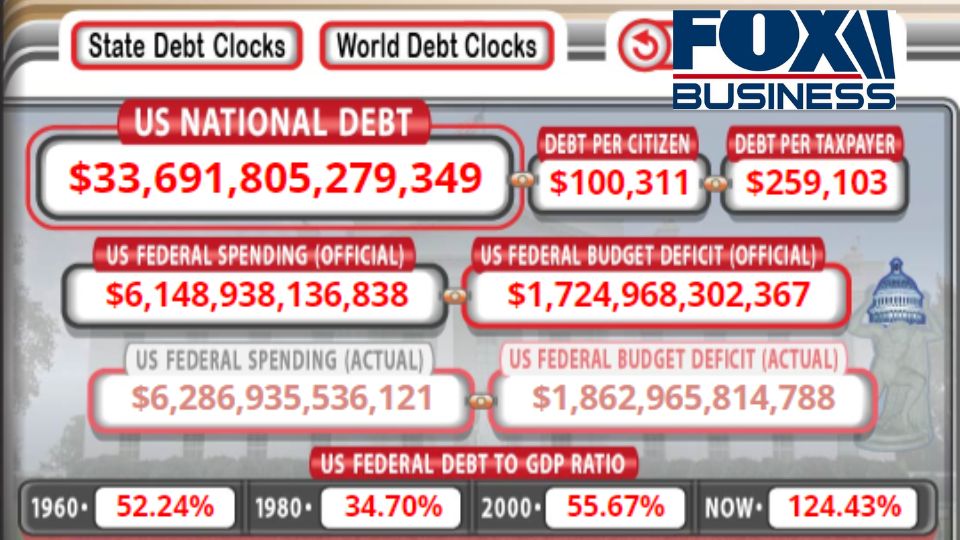- The Treasury is on track to borrow over $3 trillion this fiscal year, 50 percent more than previously estimated by the Congressional Budget Office.
- Bidenomics, perhaps best defined as the government spending, borrowing, and printing too much money, not only made the bomb larger but also caused inflation, which forced up interest rates. That was the match that lit the fuse.
- The Treasury is already spending an annualized $1 trillion to service the debt.
- Because the federal debt is $33.7 trillion, just a 1 percent increase in yields adds $337 billion to the annual cost of servicing the debt.
- Absent spending reform, eventually no one will be willing to hold the bomb anymore, and the yields on US debt will begin to resemble those in Argentina. That’s when the bomb detonates.
The latest numbers out of the Treasury Department speak volumes about how quickly things are spiraling out of control.
If you thought it was scary when the Treasury Department recently dropped a financial bomb, announcing the deficit for fiscal year 2023 was $1.7 trillion dollars, please sit down before you read on. The Treasury just released new numbers projecting borrowing of $1.6 trillion in just the first half of fiscal year 2024.
As if the 23 percent growth in last year’s deficit wasn’t enough, the Treasury is now on track to borrow almost as much in just six months as it did in the previous 12. That’s nearly a doubling of the deficit. It means the Treasury is on track to borrow over $3 trillion this fiscal year, 50 percent more than previously estimated by the Congressional Budget Office.
Besides the pandemic in 2020, America has never run deficits like the previous, current, or next quarter, at $1 trillion, $776 billion, and $816 billion, respectively. In the four quarters that preceded the pandemic, the Treasury had an average deficit of under $300 billion, about half to one-third of today’s levels.
To be clear, borrowing was much too high even before 2020. But the fact that borrowing is now almost three times as high speaks volumes about how quickly things are spiraling out of control. The federal government’s financial situation resembles a stereotypical bomb from a cartoon or cinema, spherical in shape with an impractically long fuse.
The long delay between the bomb being lit and exploding allows the incendiary to be thrown between people, none of whom want to be holding it when it goes off. As the fuse gets shorter, people more quickly throw the bomb to someone else, and that’s exactly what’s happening with Treasuries (bills, notes, and bonds) today.
After the 1990s, the federal government seemed to completely abandon the idea of a balanced budget, let alone paying off the debt. Artificially low-interest rates, courtesy of the Federal Reserve’s monetary manipulations, allowed politicians of both parties to eventually rack up a federal debt that was larger than the economy but still required only small annual interest payments to service the debt.
Such irresponsibility is how a nation builds a fiscal bomb. Bidenomics, perhaps best defined as the government spending, borrowing, and printing too much money, not only made the bomb larger but also caused inflation, which forced up interest rates. That was the match that lit the fuse.
Because the federal debt is $33.7 trillion, just a 1 percent increase in yields adds $337 billion to the annual cost of servicing the debt over time, as more of the debt is rolled over at higher interest rates. That adds to the Biden administration’s already large deficits so that higher interest costs grow the debt even faster. The Treasury is already spending an annualized $1 trillion to service the debt.
The federal government’s trajectory is entirely unsustainable, so default is inevitable if the politicians don’t course correct. As that becomes increasingly unlikely, and as the Fed continues failing to reach its 2 percent inflation target, investors are demanding higher yields as compensation. The world is realizing that Treasuries are not "risk-free," whether considering explicit default or losses from inflation.
Governments around the globe today are selling Treasuries and even the Fed is reducing its Treasury holdings. Yet, while investors the world over are finding Treasuries less appealing, the federal government is issuing more of them to cover an exploding deficit. It’s no surprise that yields on Treasuries have risen to 5 percent and are poised to go higher.
This is now a vicious cycle wherein the Biden administration and its allies in Congress continue to spend too much money, growing the deficit and debt, and further depleting confidence in Treasuries. That drives up yields and therefore the cost of servicing the debt, which makes the deficit grow even faster, which means more debt, and so on.
The Treasury’s latest admission of how fast the deficit is increasing tells America that the fuse on this bomb is nowhere near as long as we thought it was. Drastic cuts in spending would throw water on the fuse, slowing down the burn and buying the nation time to resolve the federal debt crisis.
Absent spending reform, eventually no one will be willing to hold the bomb anymore, and the yields on US debt will begin to resemble those in Argentina. That’s when the bomb detonates.
E.J. Antoni is a public finance economist at the Heritage Foundation and a senior fellow at the Committee to Unleash Prosperity.
Story by E.J. Antoni - Redacted bullet points by Jody Davis https://www.foxbusiness.com/economy/fuse-america-debt-bomb-just-got-shorter




